Bottom-Up Strategy to Forecast the Drug Location and Release Kinetics in Antitumoral Electrospun Drug Delivery Systems
Abstract
:1. Introduction
2. Results and Discussion
2.1. Chemistry
Synthesis of (NHCd)AuCl Complex
2.2. FTIR Analysis
2.3. AFM Analysis
2.4. Active Substance Release
2.5. Cytotoxicity of Free Compounds and PCL Functionalized Membranes
3. Materials and Methods
3.1. Materials
3.2. Synthesis of N, N′ Dimethyl-4-[(E)-dimethylaminodiazenyl]-5-carboxamide Imidazolium Iodide
3.3. Synthesis of N, N′ Dimethyl-4-[(E)-dimethylaminodiazenyl]-5-carboxamide Imidazolyden Gold(I) Chloride—(NHCd)AuCl
3.4. Electrospinning Procedure
3.5. Sample Preparation and Sterilization Protocol
3.6. Cell Culture
3.7. Cell Viability Assay
3.8. Statistical Analysis
3.9. Fourier Transform Infrared Spectroscopy
3.10. Morphology Analysis
3.11. Drug Release
4. Conclusions
Supplementary Materials
Author Contributions
Funding
Institutional Review Board Statement
Informed Consent Statement
Data Availability Statement
Conflicts of Interest
References
- Lyu, S.P.; Untereker, D. Degradability of Polymers for Implantable Biomedical Devices. Int. J. Mol. Sci. 2009, 10, 4033–4065. [Google Scholar] [CrossRef] [Green Version]
- Lan, X.; Wang, H.; Bai, J.; Miao, X.; Lin, Q.; Zheng, J.; Ding, S.; Li, X.; Tang, Y. Multidrug-loaded electrospun micro/nanofibrous membranes: Fabrication strategies, release behaviors and applications in regenerative medicine. J. Control Release 2021, 330, 1264–1287. [Google Scholar] [CrossRef]
- Fu, A.S.; Thatiparti, T.R.; Saidel, G.M.; Recum, H.A. Von Experimental Studies and Modeling of Drug Release from a Tunable Affinity-Based Drug Delivery Platform. Ann. Biomed. Eng. 2011, 39, 2466–2475. [Google Scholar] [CrossRef] [PubMed]
- Vulic, K.; Shoichet, M.S. Affinity-Based Drug Delivery Systems for Tissue Repair and Regeneration. Biomacromolecules 2014, 15, 3867–3880. [Google Scholar] [CrossRef]
- Wang, N.X.; Von Recum, H.A. Affinity-Based Drug Delivery. Macromol. Biosci. 2010, 11, 321–332. [Google Scholar] [CrossRef]
- Ding, S.; Khan, A.I.; Cai, X.; Song, Y.; Lyu, Z.; Du, D.; Dutta, P.; Lin, Y. Overcoming blood–brain barrier transport: Advances in nanoparticle-based drug delivery strategies. Mater. Today 2020, 37, 112–125. [Google Scholar] [CrossRef]
- Wang, S.; Zhang, X.; Yu, B.; Lee, R.J.; Lee, L.J. Targeted nanoparticles enhanced flow electroporation of antisense oligonucleotides in leukemia cells. Biosens. Bioelectron. 2010, 26, 778–783. [Google Scholar] [CrossRef] [PubMed] [Green Version]
- Deptuła, M.; Zieliński, J.; Wardowska, A.; Pikuła, M. Wound healing complications in oncological patients: Perspectives for cellular therapy. Adv. Dermatology Allergol. Dermatologii Alergol. 2019, 36, 139. [Google Scholar] [CrossRef] [PubMed]
- Zhao, Y.T.; Zhang, J.; Gao, Y.; Liu, X.F.; Liu, J.J.; Wang, X.X.; Xiang, H.F.; Long, Y.Z. Self-powered portable melt electrospinning for in situ wound dressing. J. Nanobiotechnol. 2020, 18, 111. [Google Scholar] [CrossRef]
- Lim, E.-H.; Sardinha, J.P.; Myers, S. Nanotechnology Biomimetic Cartilage Regenerative Scaffolds. Arch. Plast. Surg. 2014, 41, 231. [Google Scholar] [CrossRef]
- Guo, W.; Wang, H.; Yang, Y.; Guo, S.; Zhang, W.; Liu, Y.; Yi, X.; Ma, J.; Zhao, T.; Liu, L.; et al. Down-regulated miR-23a Contributes to the Metastasis of Cutaneous Melanoma by Promoting Autophagy. Theranostics 2017, 7, 2231. [Google Scholar] [CrossRef] [PubMed]
- Roesch, A.; Fukunaga-Kalabis, M.; Schmidt, E.C.; Zabierowski, S.E.; Brafford, P.A.; Vultur, A.; Basu, D.; Gimotty, P.; Vogt, T.; Herlyn, M. A Temporarily Distinct Subpopulation of Slow-Cycling Melanoma Cells Is Required for Continuous Tumor Growth. Cell 2010, 141, 583–594. [Google Scholar] [CrossRef] [PubMed] [Green Version]
- Turner, N.; Ware, O.; Bosenberg, M. Genetics of metastasis: Melanoma and other cancers. Clin. Exp. Metastasis 2018, 35, 379–391. [Google Scholar] [CrossRef] [PubMed]
- Welch, D.R.; Bisi, J.E.; Miller, B.E.; Conaway, D.; Seftor, E.A.; Yohem, K.H.; Gilmore, L.B.; Seftor, R.E.B.; Nakajima, M.; Hendrix, M.J.C. Characterization of a highly invasive and spontaneously metastatic human malignant melanoma cell line. Int. J. Cancer 1991, 47, 227–237. [Google Scholar] [CrossRef]
- Płachta, I.; Kleibert, M.; Czarnecka, A.M.; Spałek, M.; Szumera-Ciećkiewicz, A.; Rutkowski, P. Current diagnosis and treatment options for cutaneous adnexal neoplasms with apocrine and eccrine differentiation. Int. J. Mol. Sci. 2021, 22, 5077. [Google Scholar] [CrossRef]
- Longo, R.; Gorrasi, G.; Guadagno, L. Electromagnetically Stimuli-Responsive Nanoparticles-Based Systems for Biomedical Applications: Recent Advances and Future Perspectives. Nanomaterials 2021, 11, 848. [Google Scholar] [CrossRef]
- Guadagno, L.; Raimondo, M.; Longo, R.; Sarno, M.; Iuliano, M.; Mariconda, A.; Saturnino, C.; Ceramella, J.; Iacopetta, D.; Sinicropi, M.S. Development and characterization of antitumoral electrospun polycaprolactone/functionalized Fe3O4 hybrid membranes. Mater. Today Chem. 2020, 17, 100309. [Google Scholar] [CrossRef]
- Longo, R.; Catauro, M.; Sorrentino, A.; Guadagno, L. Thermal and mechanical characterization of complex electrospun systems based on polycaprolactone and gelatin. J. Therm. Anal. Calorim. 2022, 147, 5391–5399. [Google Scholar] [CrossRef]
- Han, D.; Steckl, A.J. Coaxial Electrospinning Formation of Complex Polymer Fibers and their Applications. Chempluschem 2019, 84, 1453–1497. [Google Scholar] [CrossRef]
- Steffens, L.; Morás, A.M.; Arantes, P.R.; Masterson, K.; Cao, Z.; Nugent, M.; Moura, D.J. Electrospun PVA-Dacarbazine nanofibers as a novel nano brain-implant for treatment of glioblastoma: In silico and in vitro characterization. Eur. J. Pharm. Sci. 2020, 143, 105183. [Google Scholar] [CrossRef]
- Steffens Reinhardt, L.; Chee, B.S.; Cao, Z.; Jaqueline Moura, D.; Nugent, M. Freeze-thaw electrospun PVA-dacarbazine nanoparticles: Preparation, characterization and anticancer evaluation. Int. J. Polym. Mater. Polym. Biomater. 2019, 69, 749–760. [Google Scholar] [CrossRef]
- Lage, H.; Aki-Sener, E.; Yalcin, I. High antineoplastic activity of new heterocyclic compounds in cancer cells with resistance against classical DNA topoisomerase II-targeting drugs. Int. J. Cancer 2006, 119, 213–220. [Google Scholar] [CrossRef] [PubMed]
- Chang, S.H.; Wu, C.Y.; Chuang, K.C.; Huang, S.W.; Li, Z.Y.; Wang, S.T.; Lai, Z.L.; Chang, C.C.; Chen, Y.J.; Wong, T.W.; et al. Imiquimod Accelerated Antitumor Response by Targeting Lysosome Adaptation in Skin Cancer Cells. J. Investig. Dermatol. 2021, 141, 2219–2228.e8. [Google Scholar] [CrossRef]
- Liu, L.; Kritsanida, M.; Magiatis, P.; Gaboriaud, N.; Wang, Y.; Wu, J.; Buettner, R.; Yang, F.; Nam, S.; Skaltsounis, L.; et al. A novel 7-bromoindirubin with potent anticancer activity suppresses survival of human melanoma cells associated with inhibition of STAT3 and Akt signaling) A novel 7-bromoindirubin with potent anticancer activity suppresses survival of human melanoma cell. Cancer Biol. Ther. 2012, 13, 1255–1261. [Google Scholar] [CrossRef] [PubMed] [Green Version]
- Iacopetta, D.; Rosano, C.; Sirignano, M.; Mariconda, A.; Ceramella, J.; Ponassi, M.; Saturnino, C.; Sinicropi, M.S.; Longo, P. Is the way to fight cancer paved with gold? Metal-based carbene complexes with multiple and fascinating biological features. Pharmaceuticals 2020, 13, 91. [Google Scholar] [CrossRef]
- Saturnino, C.; Barone, I.; Iacopetta, D.; Mariconda, A.; Sinicropi, M.S.; Rosano, C.; Campana, A.; Catalano, S.; Longo, P.; Andò, S. N-heterocyclic carbene complexes of silver and gold as novel tools against breast cancer progression. Future Med. Chem. 2016, 8, 2213–2229. [Google Scholar] [CrossRef]
- Iacopetta, D.; Mariconda, A.; Saturnino, C.; Caruso, A.; Palma, G.; Ceramella, J.; Muià, N.; Perri, M.; Sinicropi, M.S.; Caroleo, M.C.; et al. Novel Gold and Silver Carbene Complexes Exert Antitumor Effects Triggering the Reactive Oxygen Species Dependent Intrinsic Apoptotic Pathway. ChemMedChem 2017, 12, 2054–2065. [Google Scholar] [CrossRef] [PubMed]
- Mariconda, A.; Sirignano, M.; Costabile, C.; Longo, P. New NHC- silver and gold complexes active in A3-coupling (aldehyde-alkyne-amine) reaction. Mol. Catal. 2020, 480, 110570. [Google Scholar] [CrossRef]
- Costabile, C.; Mariconda, A.; Sirignano, M.; Crispini, A.; Scarpelli, F.; Longo, P. A green approach for A 3-coupling reactions: An experimental and theoretical study on NHC silver and gold catalysts†. New J. Chem 2021, 45, 18509. [Google Scholar] [CrossRef]
- Sirignano, M.; Mariconda, A.; Vigliotta, G.; Ceramella, J.; Iacopetta, D.; Sinicropi, M.S.; Longo, P. Catalytic and biological activity of silver and gold complexes stabilized by nhc with hydroxy derivatives on nitrogen atoms. Catalysts 2022, 12, 18. [Google Scholar] [CrossRef]
- Ceramella, J.; Mariconda, A.; Sirignano, M.; Iacopetta, D.; Rosano, C.; Catalano, A.; Saturnino, C.; Sinicropi, M.S.; Longo, P. Novel Au Carbene Complexes as Promising Multi-Target Agents in Breast Cancer Treatment. Pharmaceuticals 2022, 15, 507. [Google Scholar] [CrossRef] [PubMed]
- Mariconda, A.; Iacopetta, D.; Sirignano, M.; Ceramella, J.; Costabile, C.; Pellegrino, M.; Rosano, C.; Catalano, A.; Saturnino, C.; El-Kashef, H.; et al. N-Heterocyclic Carbene (NHC) Silver Complexes as Versatile Chemotherapeutic Agents Targeting Human Topoisomerases and Actin. ChemMedChem 2022, 17, e202200345. [Google Scholar] [CrossRef] [PubMed]
- Mariconda, A.; Grisi, F.; Costabile, C.; Falcone, S.; Bertolasi, V.; Longo, P. Synthesis, characterization and catalytic behaviour of a palladium complex bearing a hydroxyfunctionalized N-heterocyclic carbene ligand. New J. Chem 2014, 38, 762. [Google Scholar] [CrossRef]
- Drobota, M.; Gradinaru, L.M.; Vlad, S.; Bargan, A.; Butnaru, M.; Anghelou, M.; Aflori, M. Preparation and Characterization of Electrospun Collagen Based Composites for Biomedical Applications. Materials 2020, 13, 3961. [Google Scholar] [CrossRef]
- Natu, M.V.; de Sousa, H.C.; Gil, M.H. Effects of drug solubility, state and loading on controlled release in bicomponent electrospun fibers. Int. J. Pharm. 2010, 397, 50–58. [Google Scholar] [CrossRef] [Green Version]
- Siepmann, J.; Siepmann, F. Modeling of diffusion controlled drug delivery. J. Control Release 2012, 161, 351–362. [Google Scholar] [CrossRef]
- Guadagno, L.; Raimondo, M.; Vertuccio, L.; Lamparelli, E.P.; Ciardulli, M.C.; Longo, P.; Mariconda, A.; Della Porta, G.; Longo, R. Electrospun Membranes Designed for Burst Release of New Gold-Complexes Inducing Apoptosis of Melanoma Cells. Int. J. Mol. Sci. 2022, 23, 7147. [Google Scholar] [CrossRef]
- Gorrasi, G.; Longo, R.; Viscusi, G. Fabrication and Characterization of Electrospun Membranes Based on “Poly(ε-caprolactone)”, “Poly(3-hydroxybutyrate)” and Their Blend for Tunable Drug Delivery of Curcumin. Polymers 2020, 12, 2239. [Google Scholar] [CrossRef]
- Dogan, A.B.; Dabkowski, K.E.; von Recum, H.A. Leveraging Affinity Interactions to Prolong Drug Delivery of Protein Therapeutics. Pharmaceutics 2022, 14, 1088. [Google Scholar] [CrossRef]
- de Winter, J.C.F. Using the Student’s t-test with extremely small sample sizes. Pract. Assess. Res. Eval. 2019, 18, 10. [Google Scholar] [CrossRef]
- Saraiva, M.A. Interpretation of α-synuclein UV absorption spectra in the peptide bond and the aromatic regions. J. Photochem. Photobiol. B Biol. 2020, 212, 112022. [Google Scholar] [CrossRef] [PubMed]
- Chis, M.; Baia, M.; Cainap, C.; Chis, V. UV-vis ph dependence of dacarbazine: Experimental and td-dft investigations. Stud. Ubb Phys. 2016, 61, 9–19. [Google Scholar]
- Pavia, D.L.; Lampan, G.M.; Kriz, G.S.; Vyvyan, J.R. Introduction to Spectroscopy; Cengage Learning: Boston, MA, USA, 2014. [Google Scholar]
- Verhoeven, E.; Siepmann, F.; De Beer, T.R.M.; Van Loo, D.; Van den Mooter, G.; Remon, J.P.; Siepmann, J.; Vervaet, C. Modeling drug release from hot-melt extruded mini-matrices with constant and non-constant diffusivities. Eur. J. Pharm. Biopharm. 2009, 73, 292–301. [Google Scholar] [CrossRef] [PubMed]
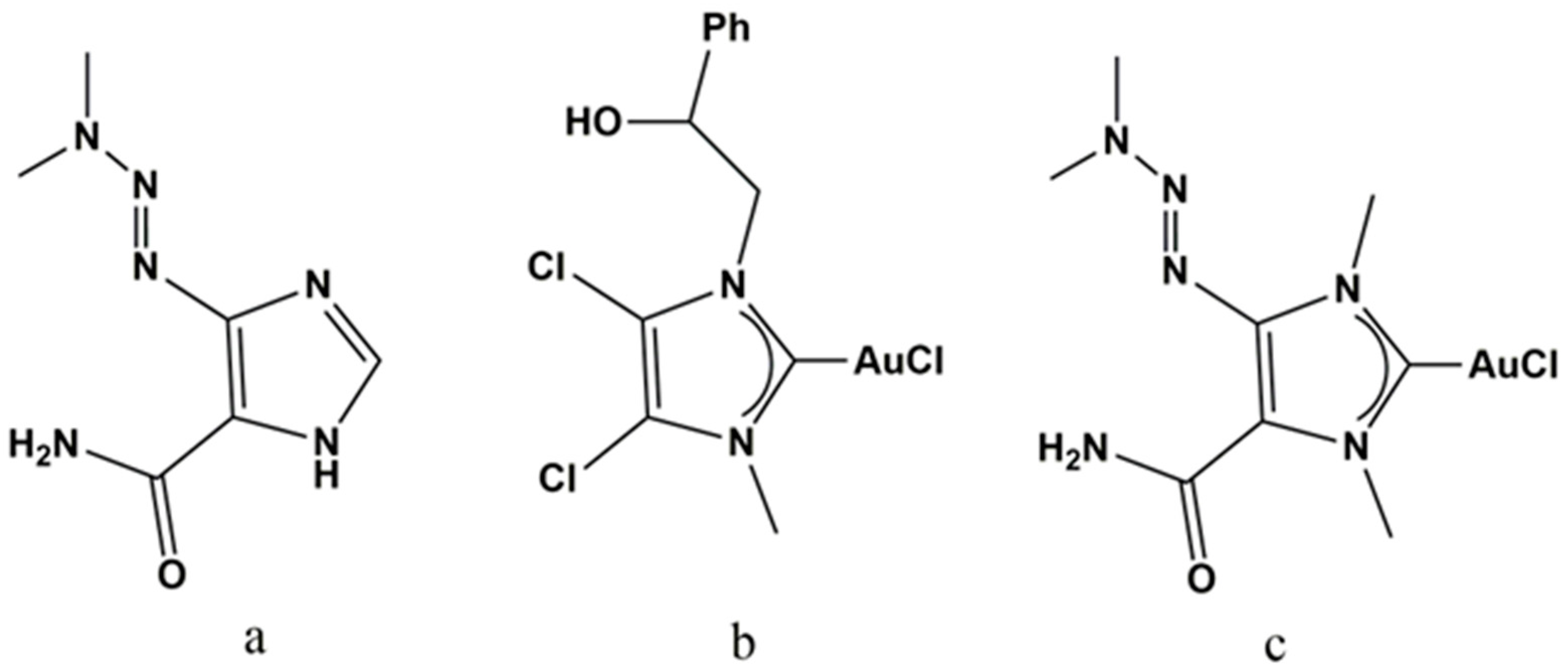

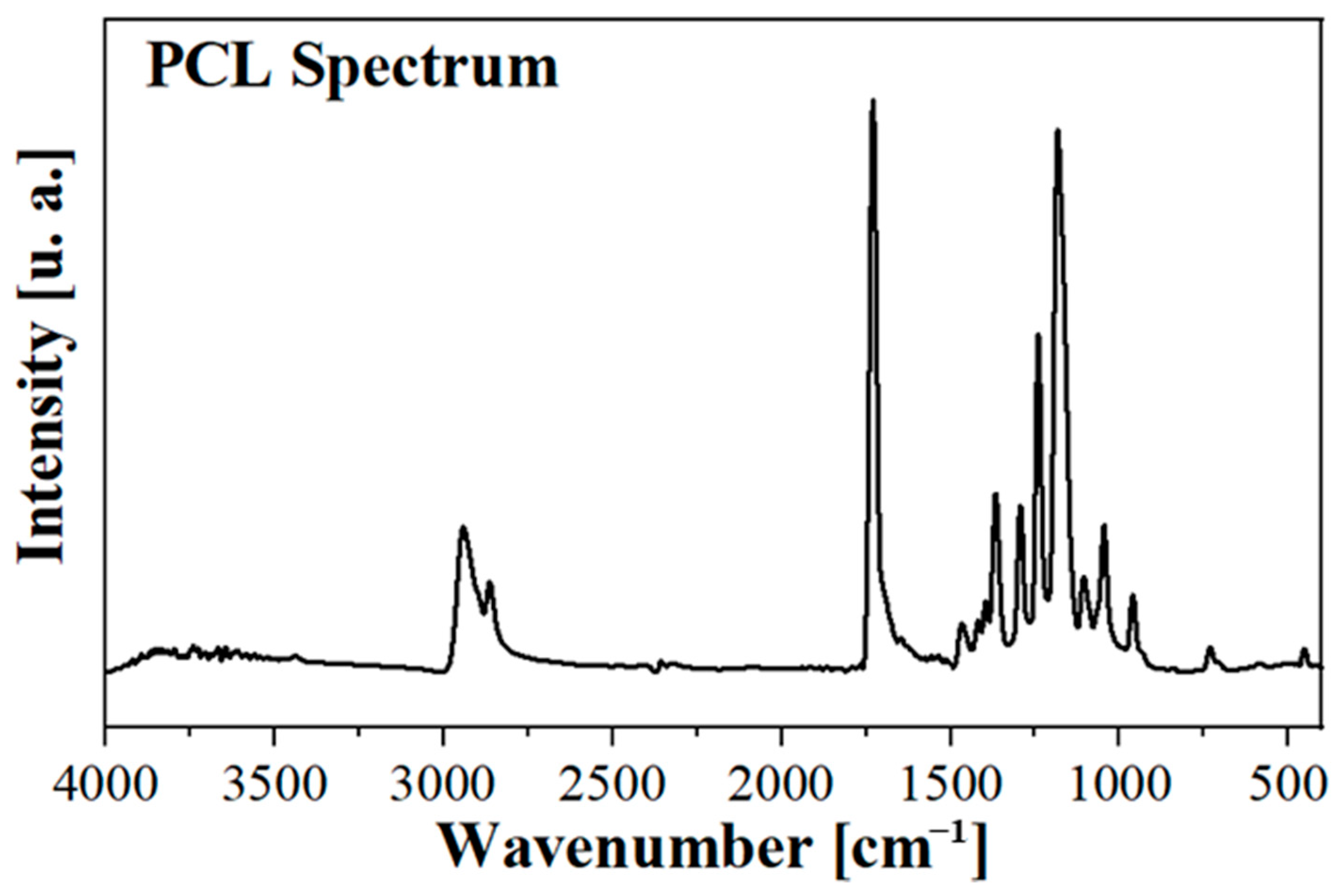
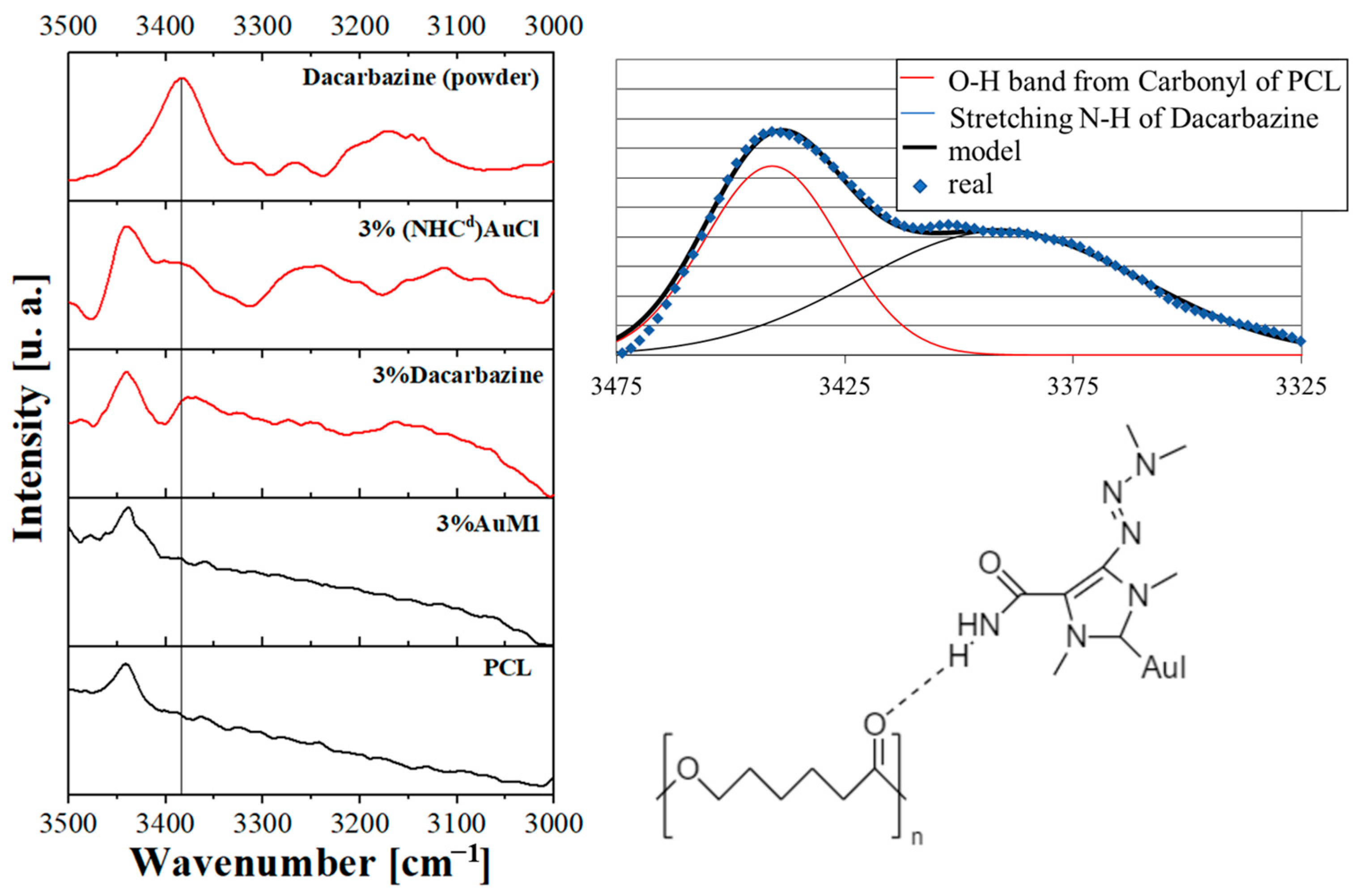

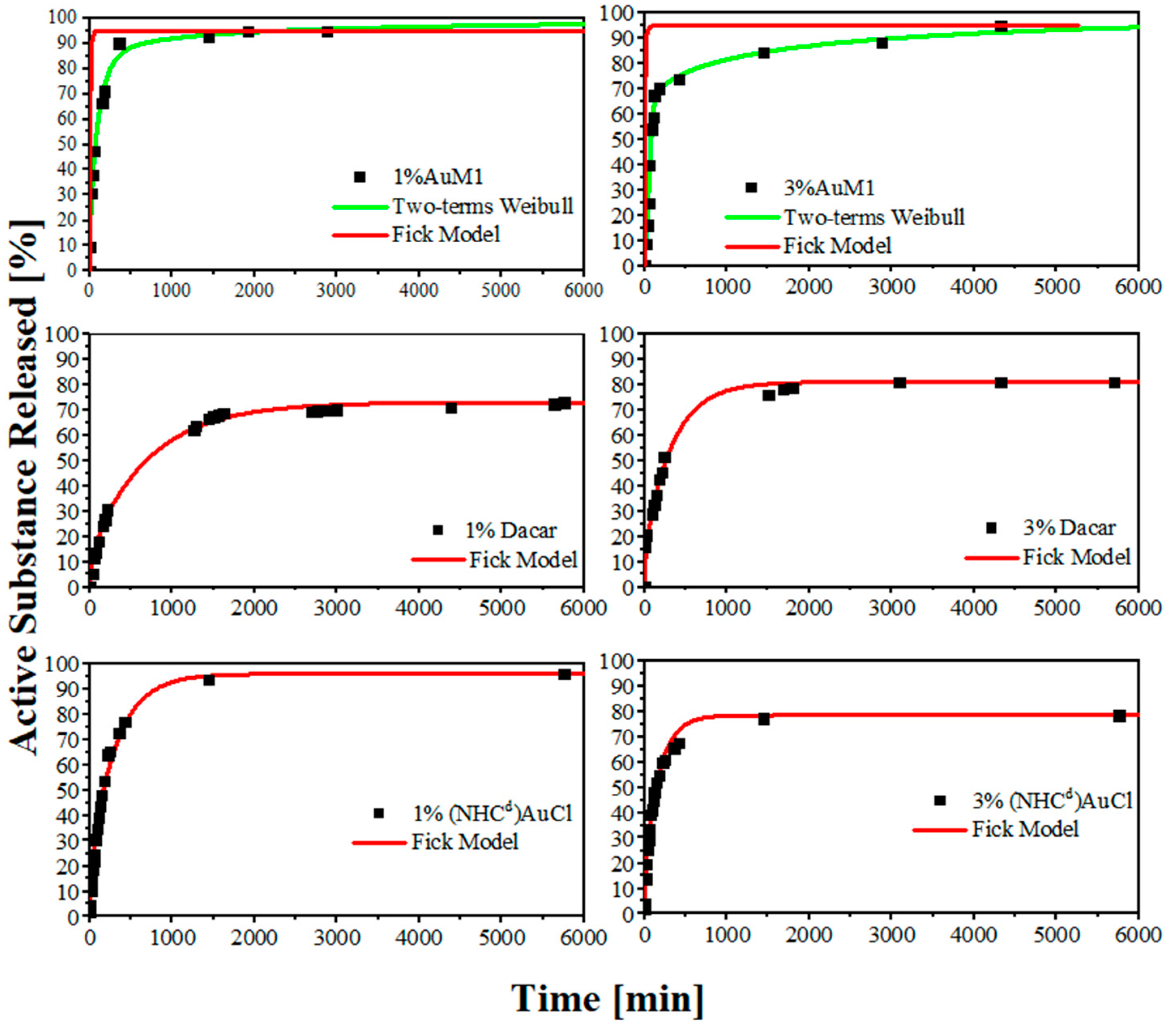

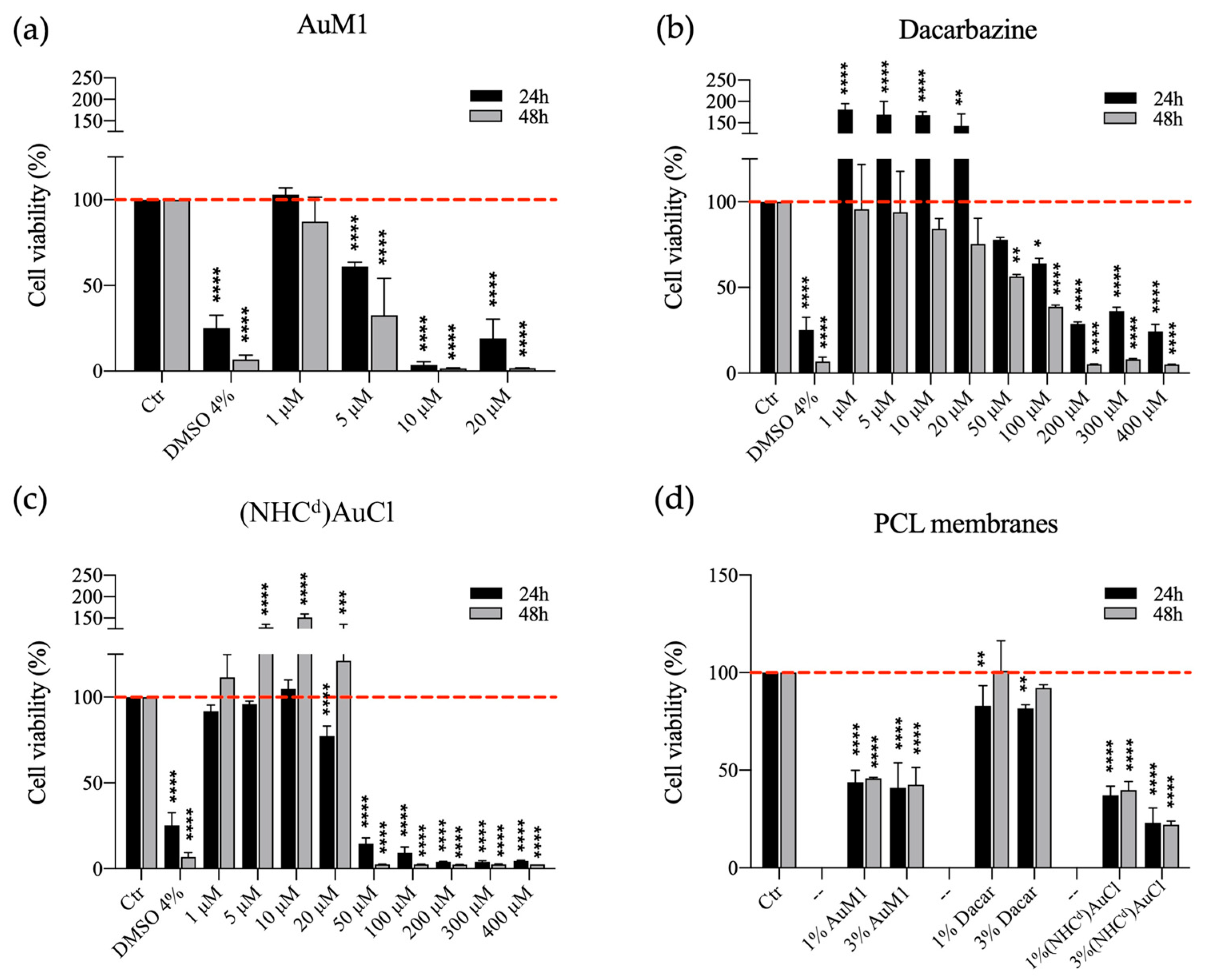
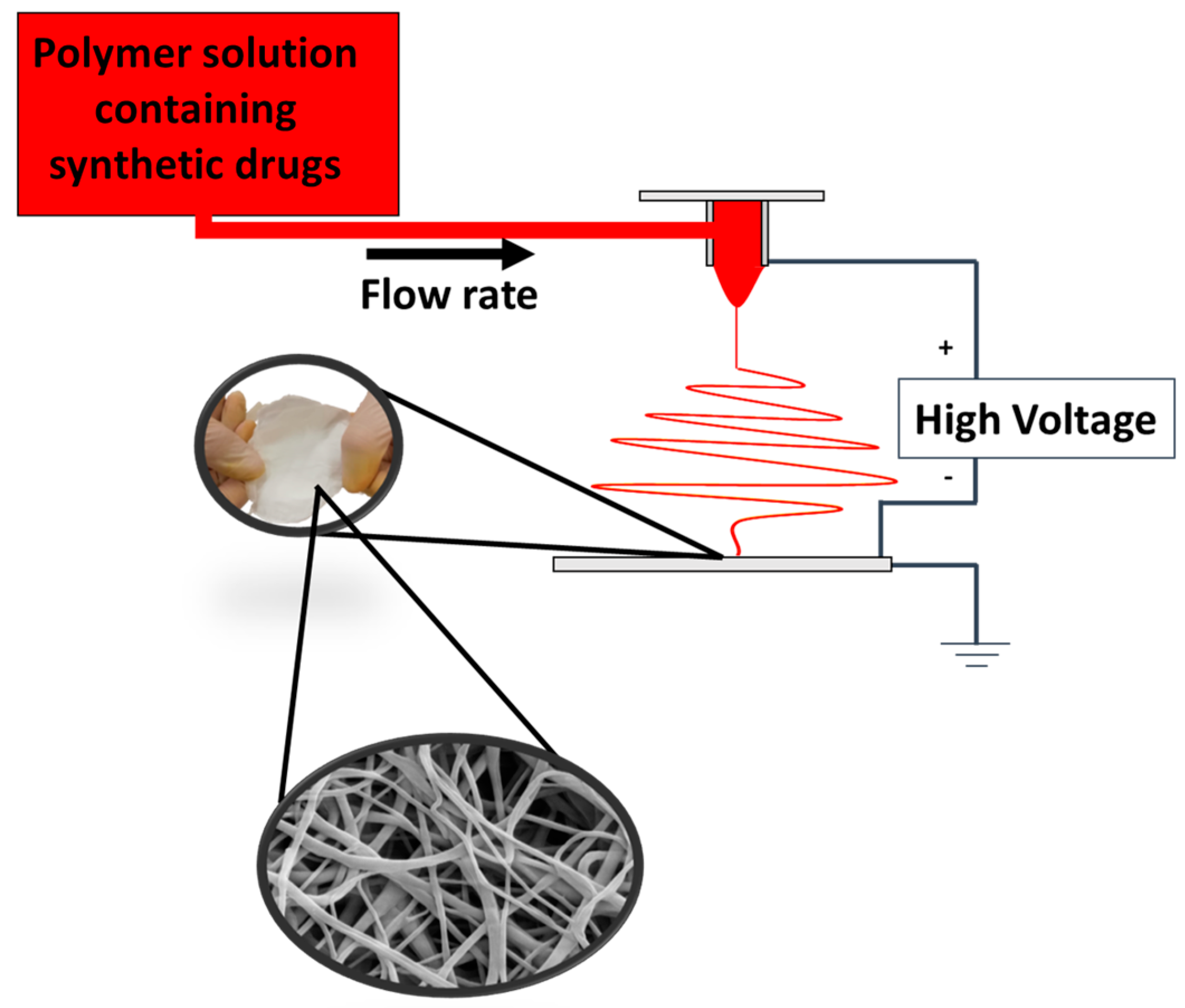
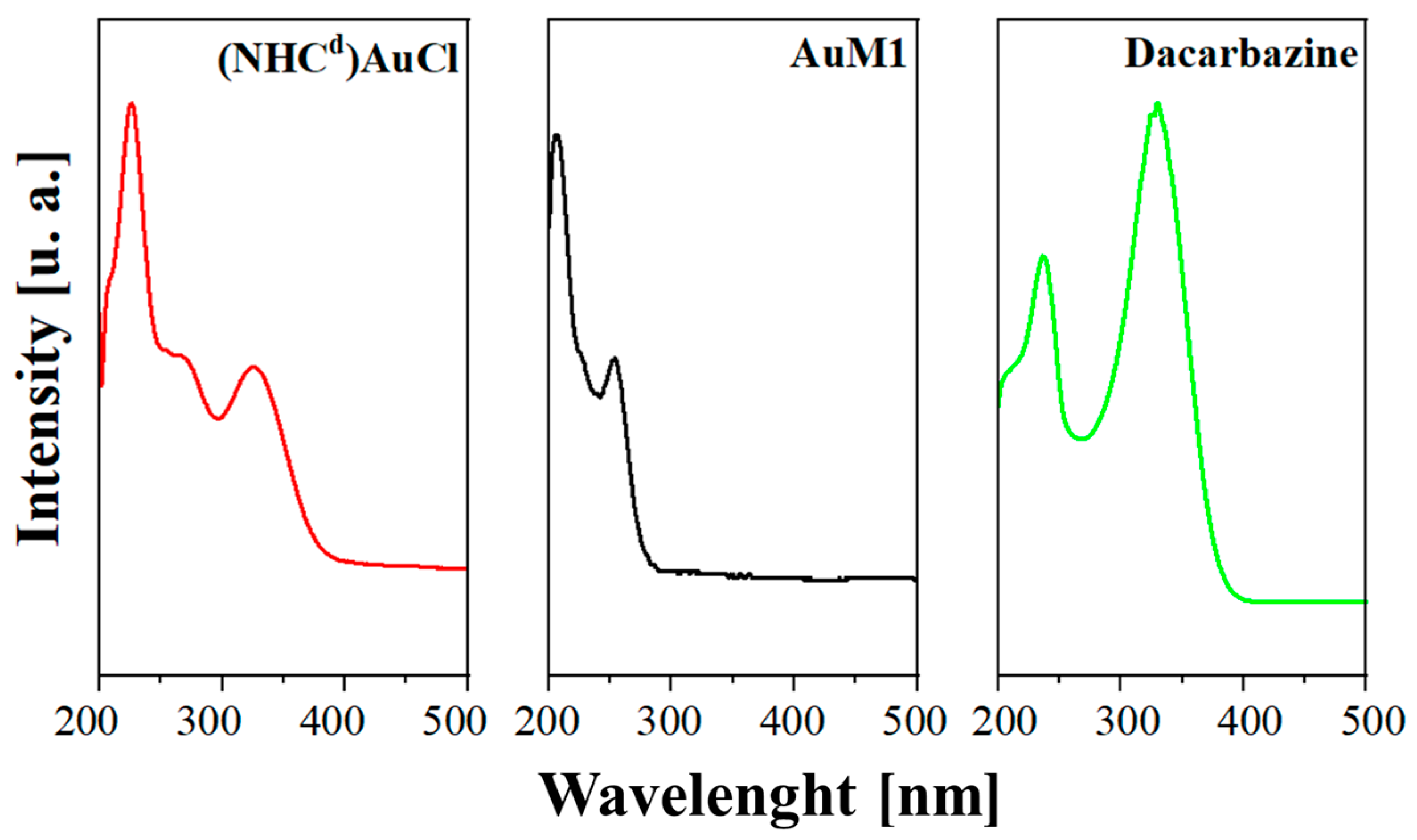
| # | Ra [nm] | Rq [nm] |
|---|---|---|
| PCL | 2.5 | 2.7 |
| 1%AuM1 | 15.7 | 23.3 |
| 3%AuM1 | 23.7 | 28.7 |
| 1%Dacar | 1.35 | 1.76 |
| 3%Dacar | 1.37 | 1.69 |
| 1%(NHCd)AuCl | 1.90 | 2.37 |
| 3%(NHCd)AuCl | 4.67 | 6.21 |
| Membrane | η |
|---|---|
| 1%AuM1 | 98.6% |
| 1%Dacar | 98.0% |
| 1%(NHCd)AuCl | 98.3% |
| 3%AuM1 | 79.1% |
| 3%Dacar | 76.0% |
| 3%(NHCd)AuCl | 74.8% |
| Weibull Parameters | 1%AuM1 | 3%AuM1 |
|---|---|---|
| θ | 0.533 | 0.544 |
| A1 [hb1] | 1.901 | 1.429 |
| b1 [-] | 1.013 | 2.027 |
| A2 [hb2] | 1.276 | 4.058 |
| b2 [-] | 0.284 | 0.461 |
| R2 | 0.985 | 0.997 |
| Electrospun Systems | D [mm2/s] | R2 |
|---|---|---|
| 1%Dacar | 2.34 × 10−8 | 0.992 |
| 3%Dacar | 4.95 × 10−8 | 0.976 |
| 1%(NHCd)AuCl | 5.44 × 10−8 | 0.980 |
| 3%(NHCd)AuCl | 1.00 × 10−8 | 0.981 |
| # | Flow Rate [mL/h] | Distance Injector-Collector [cm] | Electric Potential Difference [kV] | Active Substance |
|---|---|---|---|---|
| PCL | 2 | 28.5 | 21 | - |
| 1%AuM1 | 1 | 25 | 24 | 1% AuM1 |
| 3%AuM1 | 1 | 25 | 25 | 3% AuM1 |
| 1%Dacar | 1 | 25 | 24 | 1% Dacarbazine |
| 3%Dacar | 1 | 25 | 24 | 3% Dacarbazine |
| 1%(NHCd)AuCl | 1 | 20 | 22 | 1%(NHCd)AuCl |
| 3%(NHCd)AuCl | 0.5 | 20 | 16 | 3% (NHCd)AuCl |
| Active Substance | ε [mL × mg−1 × cm−1] |
|---|---|
| AuM1 [Peak 252 nm] | 9.8847 |
| Dacarbazine [Peak 328 nm] | 92.059 |
| (NHCd)AuCl [Peak 328 nm] | 12.549 |
Disclaimer/Publisher’s Note: The statements, opinions and data contained in all publications are solely those of the individual author(s) and contributor(s) and not of MDPI and/or the editor(s). MDPI and/or the editor(s) disclaim responsibility for any injury to people or property resulting from any ideas, methods, instructions or products referred to in the content. |
© 2023 by the authors. Licensee MDPI, Basel, Switzerland. This article is an open access article distributed under the terms and conditions of the Creative Commons Attribution (CC BY) license (https://creativecommons.org/licenses/by/4.0/).
Share and Cite
Longo, R.; Raimondo, M.; Vertuccio, L.; Ciardulli, M.C.; Sirignano, M.; Mariconda, A.; Della Porta, G.; Guadagno, L. Bottom-Up Strategy to Forecast the Drug Location and Release Kinetics in Antitumoral Electrospun Drug Delivery Systems. Int. J. Mol. Sci. 2023, 24, 1507. https://doi.org/10.3390/ijms24021507
Longo R, Raimondo M, Vertuccio L, Ciardulli MC, Sirignano M, Mariconda A, Della Porta G, Guadagno L. Bottom-Up Strategy to Forecast the Drug Location and Release Kinetics in Antitumoral Electrospun Drug Delivery Systems. International Journal of Molecular Sciences. 2023; 24(2):1507. https://doi.org/10.3390/ijms24021507
Chicago/Turabian StyleLongo, Raffaele, Marialuigia Raimondo, Luigi Vertuccio, Maria Camilla Ciardulli, Marco Sirignano, Annaluisa Mariconda, Giovanna Della Porta, and Liberata Guadagno. 2023. "Bottom-Up Strategy to Forecast the Drug Location and Release Kinetics in Antitumoral Electrospun Drug Delivery Systems" International Journal of Molecular Sciences 24, no. 2: 1507. https://doi.org/10.3390/ijms24021507







